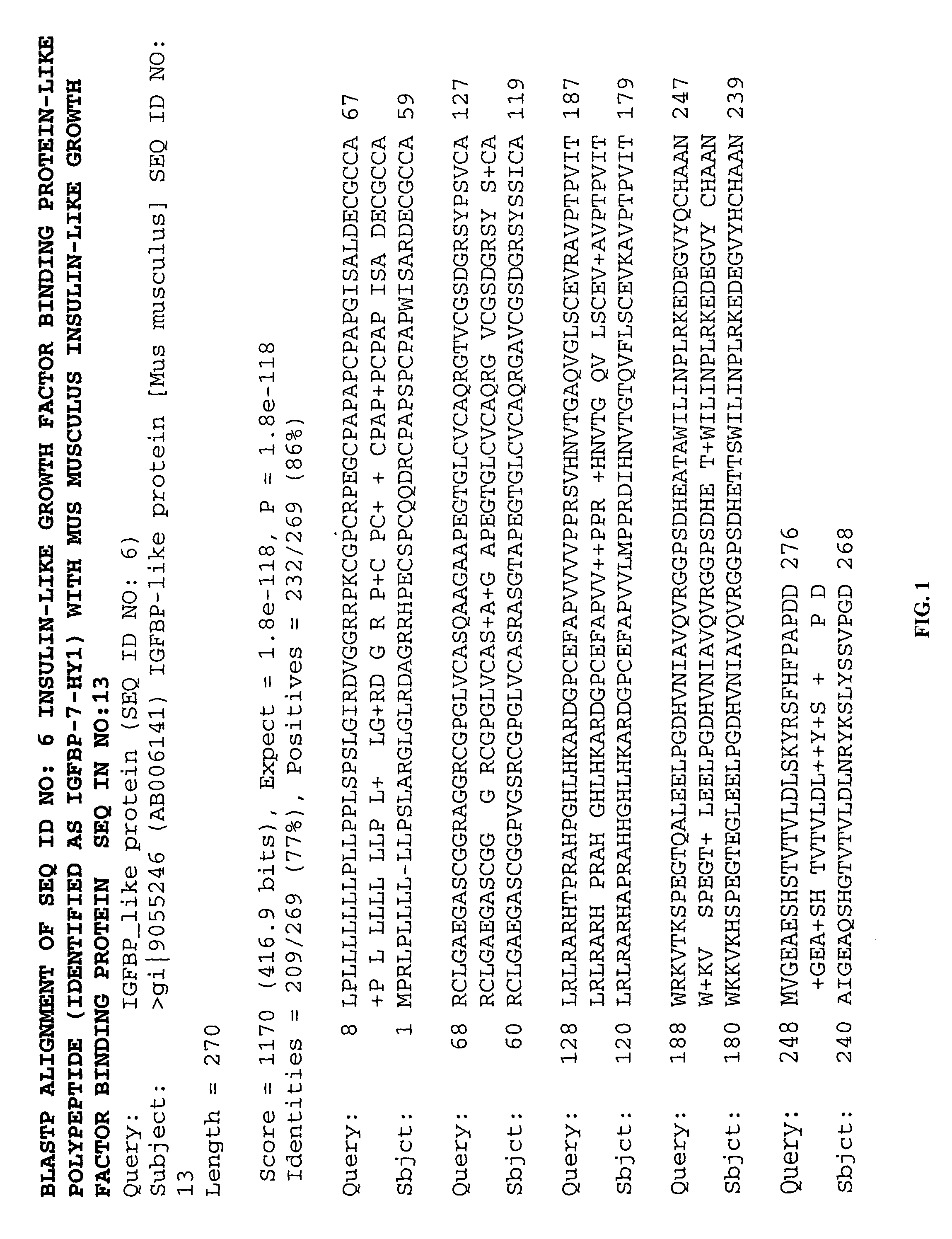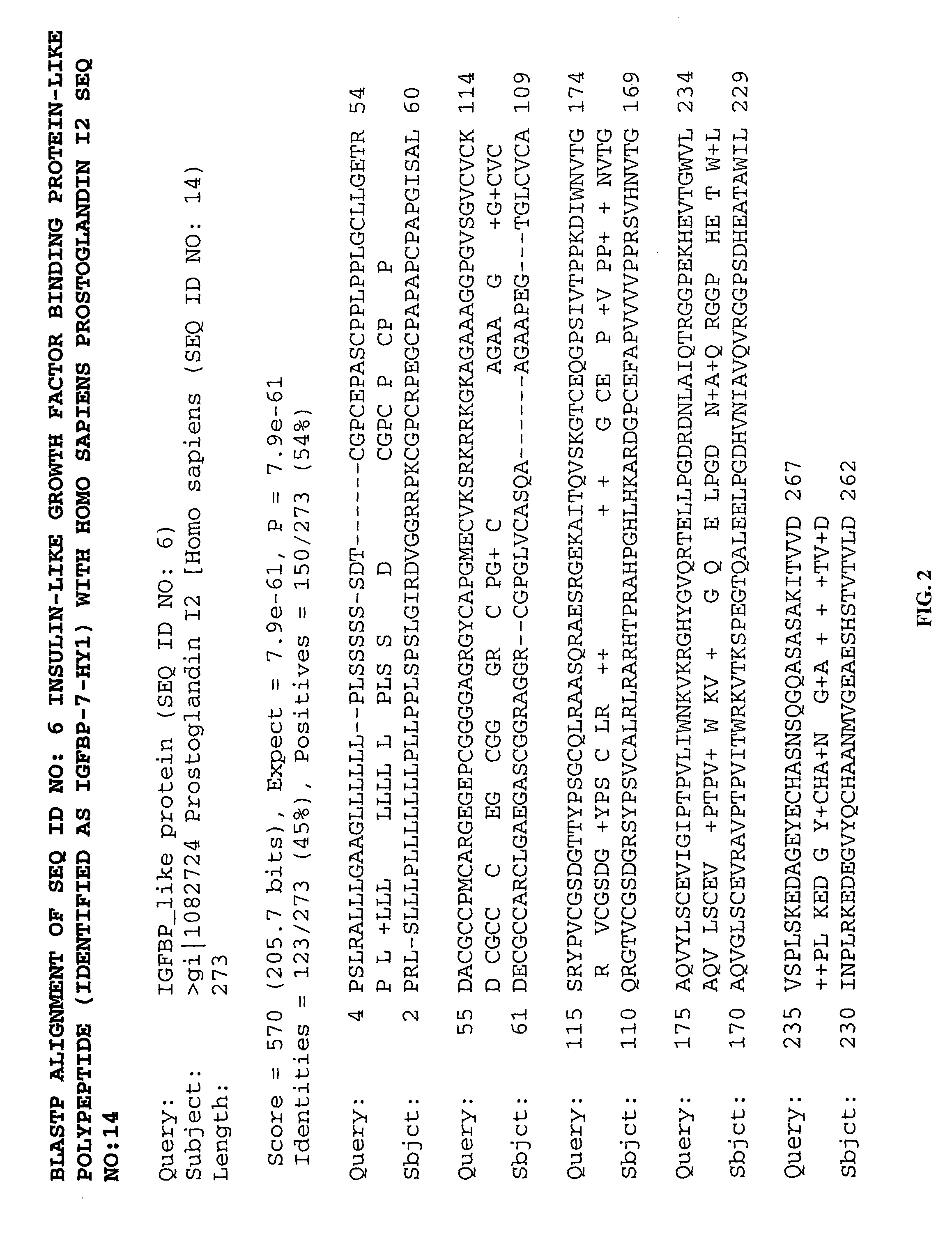Methods of therapy and diagnosis using insulin-like growth factor binding protein-like polypeptides and polynucleotides
a technology of growth factor and polypeptide, which is applied in the field of polynucleotides and proteins, can solve the problems of insufficient differentiation of endometrium, cancer risk, and circulating igfbp-3 levels, and achieve the effects of reducing the activity of igf hormones, promoting female reproductive health and embryo development, and increasing wound healing
- Summary
- Abstract
- Description
- Claims
- Application Information
AI Technical Summary
Benefits of technology
Problems solved by technology
Method used
Image
Examples
example 1
Isolation of SEQ ID NO: 1 from a cDNA Library of Adrenal Gland and SEQ ID NO: 2 from a cDNA Library of Thymus
[0441]A plurality of novel nucleic acids were obtained from cDNA libraries including those prepared from adrenal gland mRNA (Clontech) (SEQ ID NO: 1) and thymus mRNA (Clontech) (SEQ ID NO: 2) using standard PCR, sequencing by hybridization sequence signature analysis, and Sanger sequencing techniques. The inserts of the library were amplified with PCR using primers specific for vector sequences flanking the inserts. These samples were spotted onto nylon membranes and interrogated with oligonucleotide probes to give sequence signatures. The clones were clustered into groups of similar or identical sequences, and single representative clones were selected from each group for gel sequencing. The 5′ sequence of the amplified inserts was then deduced using the reverse M13 sequencing primer in a typical Sanger sequencing protocol. PCR products were purified and subjected to fluores...
example 2
Assemblage of SEQ ID NO: 3 and 4
[0442]The nucleic acid of the present invention, designated as SEQ ID NO: 3 was assembled using SEQ ID NO: 1 as a seed. Then a recursive algorithm was used to extend the seed into an extended assemblage, by pulling additional sequences from different databases (i.e., Hyseq's database containing EST sequences, dbEST version 115, gb pri 115, UniGene version 103, and exons from public domain genomic sequences predicted by Genscan) that belong to this assemblage. The algorithm terminated when there was no additional sequences from the above databases that would extend the assemblage. Inclusion of component sequences into the assemblage was based on a BLASTN hit to the extending assemblage with BLAST score greater than 300 and percent identity greater than 95%.
[0443]The nucleic acid of the present invention, designated as SEQ ID NO: 4 was assembled using SEQ ID NO: 2 as a seed. Then a recursive algorithm was used to extend the seed into an extended assembl...
example 3
Assemblage of SEQ ID NO: 5 and 6
[0447]A recursive algorithm was used to extend sequences, by pulling sequences from Hyseq's database of EST sequences and by pulling additional sequences from different databases (i.e., dbEST version 121, gb pri 121, and UniGene version 121) that belong to this assemblage. The algorithm terminated when there was no additional sequence from the above databases that would extend the assemblage. Inclusion of the component sequences into the assemblage was based on a BLASTN hit to the extending assemblage with BLAST score greater than 300 and percent identity greater 85%.
[0448]Using PHRAP (Univ. of Washington), a full-length gene cDNA sequence was generated from the assemblage. Hyseq ESTs SEQ ID NO: 1 and 2 were incorporated into the extended gene sequence SEQ ID NO: 5 during the assembly process. Any frame shifts and incorrect stop codons were corrected by hand editing. During editing, the sequence was checked using FASTY and / or BLAST against Genbank (i....
PUM
| Property | Measurement | Unit |
|---|---|---|
| molecular mass | aaaaa | aaaaa |
| molecular weight | aaaaa | aaaaa |
| weight | aaaaa | aaaaa |
Abstract
Description
Claims
Application Information
 Login to View More
Login to View More - R&D
- Intellectual Property
- Life Sciences
- Materials
- Tech Scout
- Unparalleled Data Quality
- Higher Quality Content
- 60% Fewer Hallucinations
Browse by: Latest US Patents, China's latest patents, Technical Efficacy Thesaurus, Application Domain, Technology Topic, Popular Technical Reports.
© 2025 PatSnap. All rights reserved.Legal|Privacy policy|Modern Slavery Act Transparency Statement|Sitemap|About US| Contact US: help@patsnap.com


